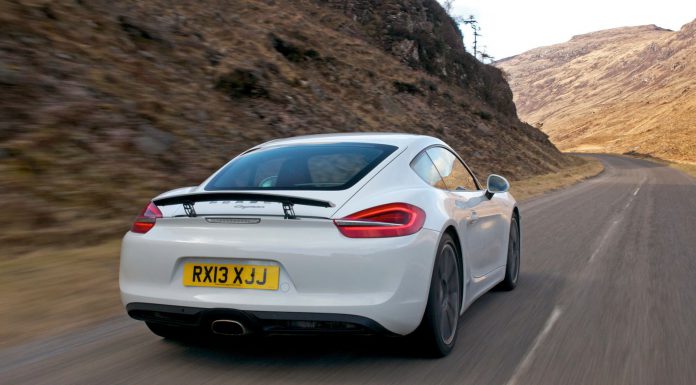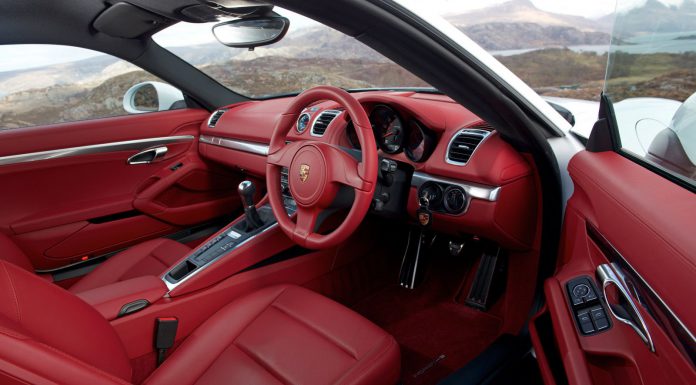The Porsche Cayman is often described as being the poor man’s Porsche, yet actually, if you speak to anyone who’s driven one, you’ll be told that simply isn’t true. Whilst it might look like a cross between a Boxster and a 911 Carrera, the Porsche Cayman has traditionally had a reputation as a surprisingly good coupe. In its latest generation, it has more bulk and curve to its body panels, alongside a small power increase. We drove it in Scotland, this is our story.
The 2013 Porsche Cayman received its official debut around 6 months ago at the Los Angeles Motor Show. In its second generation, the Porsche Cayman continues along much the same lines as its predecessor. It has a mid-engined platform shared with the entry-level convertible Porsche Boxter along with familiar power plants inherited from the outgoing model. Yet a lot has changed, despite what the spec sheet might indicate.
The 2013 Porsche Cayman feels more mature and less awkward than the car it replaces. It no longer looks like the poor man’s alternative to the 911. Porsche have injected some desirability into the package which helps immeasurably. As with all Porsche products, the Cayman is less about a dramatic design and all about the drive.
The 2013 Porsche Cayman grows by 3.3cm’s in total with a 6cm longer wheelbase and a 1cm lower roof line. The front track grows by 1.35cm on the standard Cayman. As a result, you get more space inside both for passengers and for luggage. This latest generation, despite the bloat, feels as though it has grown in many other ways too. Whereas the first generation tendered to lack an individual character, nothing could be further from the truth with the latest car.
Despite the growth, a blend of mild steels and aluminium help reduce weight by 30kg over the older model. The goal for Porsche’s chassis designers was to create a car that blends performance and handling with comfort and practicality. Afterall, many of those that purchase the Porsche Cayman will want to use it every day.
The Porsche Cayman has a well balanced setup as standard, yet we suspect many will opt to spec the Porsche Active Suspension Management (PASM). This provides owners with an adaptive damping system, programmable through the touch of a button on the centre console. The Sport button activates a harder suspension setup whilst Sport + optimises the setup for track use.
Another option you might want to consider is the Porsche Torque Vectoring (PTV) system which varies the distribution of torque to the wheels. Essentially this helps you corner even faster by playing with the torque, sending it to the inside wheel the moment you turn into a corner. Coupled with the rear mechanical limited slip differential, stability and balance have never been better. One point of contention is the Electromechanical steering, first introduced on the Porsche 991 Carrera. It got lukewarm reviews to say the least, yet Porsche appear to have worked on it for the new Cayman as it provides a more direct feeling with the option to program it to suit the circumstances.
Since the existing buyer profile of the last generation Porsche Cayman consists of many driving purists the stock equipment is quite basic with things as aircondition as standard but more luxury items like an automatic duo-zone climate control as optional extra. With the practicality of the Cayman (it has plenty of luggage space in the front and rear) we would spec it with a few of the luxury extra’s mentioned before to make it more comfortable for daily usage.
The entry-level Porsche Cayman uses a rear-mounted flat-six, quad-cam engine. The Cayman has a 2.7 litre version with a total output of 275hp, offered with a choice of six-speed manual or a seven-speed PDK twin-clutch. Zero to 60mph is dispatched in 5.4 seconds, cars equipped with the optional PDK gearbox see a slightly quicker 5.3 second time. The gain is reversed when it comes to top speed with the manual managing 165mph against the PDK’s 164mph.
Talking about the manual and PDK gearbox, we had the chance to try both during our stay in Scotland. In the latest generation Porsche 911 the difference between the PDK and 7-speed manual gearbox is quite significant in favour of the PDK in terms of performance and desirability. In the Cayman however the difference between the manual gearbox and PDK is smaller and mostly comes down to personal preference. In our case we prefer the Cayman with a manual gearbox.
Driving through the Scottish Highlands it quickly becomes clear that the Cayman feels at home on twisty mountain roads and long sweeping bends. The weight distribution is close to perfect and the car is well balanced even when the road surface changes from smooth asphalt to bumpy concrete. In higher revs the 2.7 litre engine and standard exhaust fills the cabin with an addictive full-bodied sound. Which in comparison sounds better and slightly louder than the twin tip exhaust of the more powerful 3.4 liter Cayman S brother.
The 2013 Porsche Cayman is a surprisingly good and all-round car and only in direct comparison with a 911 you will ever feel like driving an ‘entry-level’ Porsche. The new Porsche Cayman is desirable enough to prompt customers to not even consider the 911, the only question is if the 2.7 liter is enough for you or you should go for the 3.4 liter S model. We will answer that question in our upcoming review of the 2013 Porsche Cayman S!


















































Fantastic photos! Thanks!
I spent a good hour on Sunday looking at the new Cayman. The new flat rear hatch and flatter roof, lead me to a funny conclusion… the new 981 Cayman looks like the designers have combined elements of BMW's Z4 with Porsche's original 987 Cayman. The modern Cayman looks a bit more BMW and less traditional Porsche 911.
I currently own a 987 Cayman and had spent a good amount of time test driving BMW's Z4 before choosing the Cayman. The Cayman won-out as it offered a more pure sports car feel vs BMW. The new Cayman looks like they've tried to combine the Z4's luxury, with the original Cayman's sportiness.
I will be taking a test drive soon. Going to be looking at the new DFI 2.7 engine over my current 2.9 and seeing if the drop in torque is worth the gain in HP?
I will be also testing to see if the new wider longer wheelbase and electric steering make the car more stable at high speed, at the expenses of "fun to drive" under daily driving conditions.
And I want to see if the new bigger interior, bigger dashboard, and wider center luxury console take away from my current direct (go cart view) of the pavement… now that the New Cayman has gone "Panamera" with its interior.
Watching the new car role-out process is always a lot of fun… but the funniest line from Porsche has been- "Now it looks less like a 911" like that's a good thing? I've never been a big 911 fan, I bought the orginal Cayman because I liked the mid-engine layout. But being confused by 9 out out of 10 people with Porsche's iconic 911 was never something I thought was a negative. LOL
Amazing (y)
Might one suggest that a car-enthusiast medium ought to know how to spell Boxster?
Absolutely right! We have fixed it!
PORSCHE CAYMAN it's awesome big boy toy.
As a mountain and ski country dweller, I would love to know how this handles the wet and snowy as compared to the Carrera 4 and if I'm sacrificing anything significant minus the AWD…I'm always reading how Boxster owners pack their babies away for the winter and that would be a shame if I really had to do that.
Waaaaaaaaaa porsche! :P